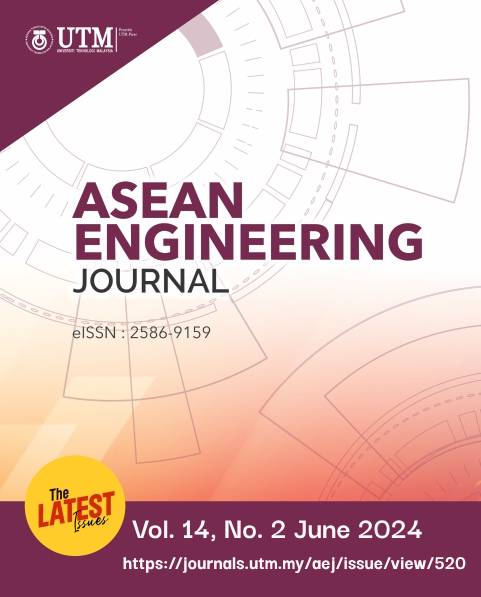INFLUENCE OF CALCINATION TEMPERATURE ON CIPROFLOXACIN PHOTODEGRADATION BY VANADIUM PENTOXIDE / GRAPHITIC CARBON NITRIDE PHOTOCATALYST
DOI:
https://doi.org/10.11113/aej.v14.21315Keywords:
Catalysts; Photocatalysis; Porous Materials; Pyrolysis; CiprofloxacinAbstract
The employment of vanadium pentoxide (V2O5) as a photocatalyst has been widely utilized owing to its promising supercapacitor properties for photocatalysis applications under visible light without any alteration. Up to date, there has yet to be a report on the investigation of calcination temperature effect on V2O5 and graphitic carbon nitride (g-C3N4) combination photocatalyst synthesis for ciprofloxacin (CIP) photodegradation. In this study, the V2O5 / g-C3N4 photocatalyst is synthesized using simple and facile calcination process. The properties of the synthesized V2O5 / g-C3N4 were evaluated in terms of porosity, surface morphology and composition elements, and its band gap value to well understand its’ behaviour and interaction with CIP pollutants. The best synthesis conditions for V2O5 / g-C3N4 photocatalyst on CIP photocatalysis were at 500 °C (500VC) with 90.17 % CIP photodegradation performance. This research has provided a useful future reference in the field of photocatalysis research.
References
A. Tarafdar et al. 2022.“The hazardous threat of Bisphenol A: Toxicity, detection and remediation,” Journal of Hazardous Materials, 423: 127097. doi: 10.1016/j.jhazmat.2021.127097.
J. Qiao and Y. Xiong. 2021. “Electrochemical oxidation technology: A review of its application in high-efficiency treatment of wastewater containing persistent organic pollutants,” Journal of Water Process Engineering, 44: 102308. doi: 10.1016/j.jwpe.2021.102308.
V. Vaezzadeh et al. 2021. “Examination of barnacles’ potential to be used as bioindicators of persistent organic pollutants in coastal ecosystem: A Malaysia case study,” Chemosphere, 263: 128272. doi: 10.1016/j.chemosphere.2020.128272.
S. Kumar (S. Kumar), R. D. Kaushik, and L. P. Purohit. 2022. “ZnO-CdO nanocomposites incorporated with graphene oxide nanosheets for efficient photocatalytic degradation of bisphenol A, thymol blue and ciprofloxacin,” Journal of Hazardous Materials. 424: 127332, 202. doi: 10.1016/j.jhazmat.2021.127332.
R. Wang et al. 2023. “Cobalt-doped V2O5 hexagonal nanosheets for superior photocatalytic toxic pollutants degradation, Cr (VI) reduction, and photoelectrochemical water oxidation performance,” Environmental Resources, 217: 114923. doi: 10.1016/j.envres.2022.114923.
L. Parashuram et al. 2022. “Nitrogen doped carbon spheres from Tamarindus indica shell decorated with vanadium pentoxide; photoelectrochemical water splitting, photochemical hydrogen evolution & degradation of Bisphenol A,” Chemosphere, 287: 132348. doi: 10.1016/j.chemosphere.2021.132348.
H. Chaudhary et al. 2021. “Fabrication of reduced Graphene Oxide supported Gd3+ doped V2O5 nanorod arrays for superior photocatalytic and antibacterial activities,” Ceramic International, 47: 32521–32533. doi: 10.1016/j.ceramint.2021.08.146.
S. Sekar et al. 2021. “Graphitic carbon-encapsulated V2O5 nanocomposites as a superb photocatalyst for crystal violet degradation,” Environmental Resources, 112201. doi: 10.1016/j.envres.2021.112201.
X. Zhang et al. 2021. “V2O5/P-g-C3N4 Z-scheme enhanced heterogeneous photocatalytic removal of methyl orange from water under visible light irradiation,” Colloids and Surfaces A Physicochemical Engineering Aspects, 608: 125580. doi: 10.1016/j.colsurfa.2020.125580.
N. Ding et al. 2022. “Fluorinated inverse opal carbon nitride combined with vanadium pentoxide as a Z-scheme photocatalyst with enhanced photocatalytic activity,” Chinese Chemical Letter, vol. 33: no. 8, pp. 3797–3801. doi: 10.1016/j.cclet.2021.11.042.
J. Liu, X. Wei, W. Sun, X. Guan, X. Zheng, and J. Li. 2021. “Fabrication of S-scheme CdS-g-C3N4-graphene aerogel heterojunction for enhanced visible light driven photocatalysis,” Environmental Resources, 197: 111136. doi: 10.1016/j.envres.2021.111136.
J. H. Shen, T. H. Chiang, C. K. Tsai, Z. W. Jiang, and J. J. Horng. 2022. “Mechanistic insights into hydroxyl radical formation of Cu-doped ZnO/g-C3N4composite photocatalysis for enhanced degradation of ciprofloxacin under visible light: Efficiency, kinetics, products identification and toxicity evaluation,” Journal of Environmental Chemical Engineering, 10: 107352. doi: 10.1016/j.jece.2022.107352.
S. Le et al. 2021. “V2O5 nanodot-decorated laminar C3N4 for sustainable photodegradation of amoxicillin under solar light,” Applied Catalysis B Environmental, 303: 120903. doi: 10.1016/j.apcatb.2021.120903.
T. Xie et al. 2019. “Synthesis of multifunctional photocatalyst vanadium oxide/activated carbon via in situ utilization of stone coal ore,” Ceramic International, 45: 4934–4944. doi: 10.1016/j.ceramint.2018.11.193.
N. Q. Thang et al. 2021. “Localized surface plasmonic resonance role of silver nanoparticles in the enhancement of long-chain hydrocarbons of the CO2 reduction over Ag-gC3N4/ZnO nanorods photocatalysts,” Chemical Engineering. Science, 229: 116049. doi: 10.1016/j.ces.2020.116049.
S. Phromma, T. Wutikhun, P. Kasamechonchung, T. Eksangsri, and C. Sapcharoenkun. 2020. “Effect of calcination temperature on photocatalytic activity of synthesized TiO2 nanoparticles via wet ball milling sol-gel method,” Applied Sciences, 10: no. 3. doi: 10.3390/app10030993.
A. A. Yadav, Y. M. Hunge, S. W. Kang, A. Fujishima, and C. Terashima. 2023. “Enhanced Photocatalytic Degradation Activity Using the V2O5/RGO Composite,” Nanomaterials, 13: pp. 1–10. doi: 10.3390/nano13020338.
S. Vignesh et al. 2022. “Investigation of heterojunction between α-Fe2O3/V2O5 and g-C3N4 ternary nanocomposites for upgraded photo-degradation performance of mixed pollutants: Efficient dual Z-scheme mechanism,” Journal of Alloys Compound, 902: 163705. doi: 10.1016/j.jallcom.2022.163705.
Y. N. Zang et al. 2021. “A biochar-promoted V2O5/g-C3N4Z-Scheme heterostructure for enhanced simulated solar light-driven photocatalytic activity,” Royal Science Chemistry Advances, 11: 15106–15117. doi: 10.1039/d1ra02712c.
M. G. Kim et al. 2021. “Effects of Calcination Temperature on the Phase Composition, Photocatalytic Degradation, and Virucidal Activities of TiO2Nanoparticles,” American Chemical Society Omega, 6: 10668–10678. doi: 10.1021/acsomega.1c00043.
L. Huang et al. 2018. “Influence of calcination temperature on the plate-type V2O5–MoO3/TiO2 catalyst for selective catalytic reduction of NO,” Reaction Kinetic Mechanism Catalysis, 124: 603–617. doi: 10.1007/s11144-018-1378-0.
K. Duan et al. 2022. “A facile route to synthesize n-SnO2/p-CuFe2O4 to rapidly degrade toxic methylene blue dye under natural sunlight,” Royal Science Chemistry Advances, 12: 16544–16553. doi: 10.1039/d2ra01690g.
















